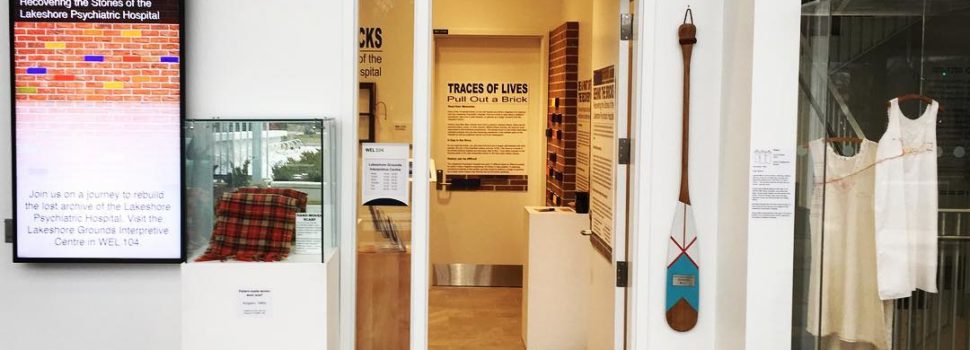
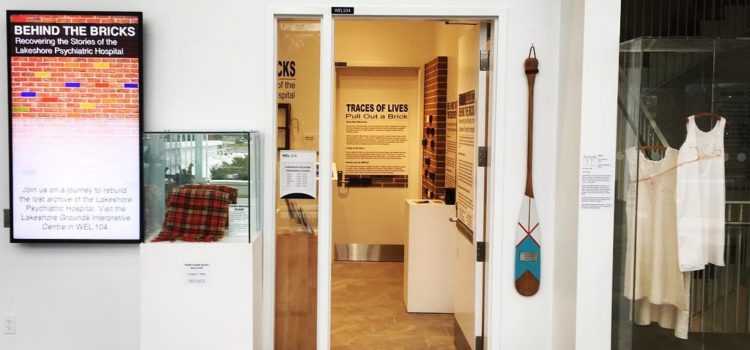
Small Space, Big Ideas: How to do an art exhibition
CultureEtobicokeHumberTorontoUncategorized Mar 3, 2020 Mariana Belham
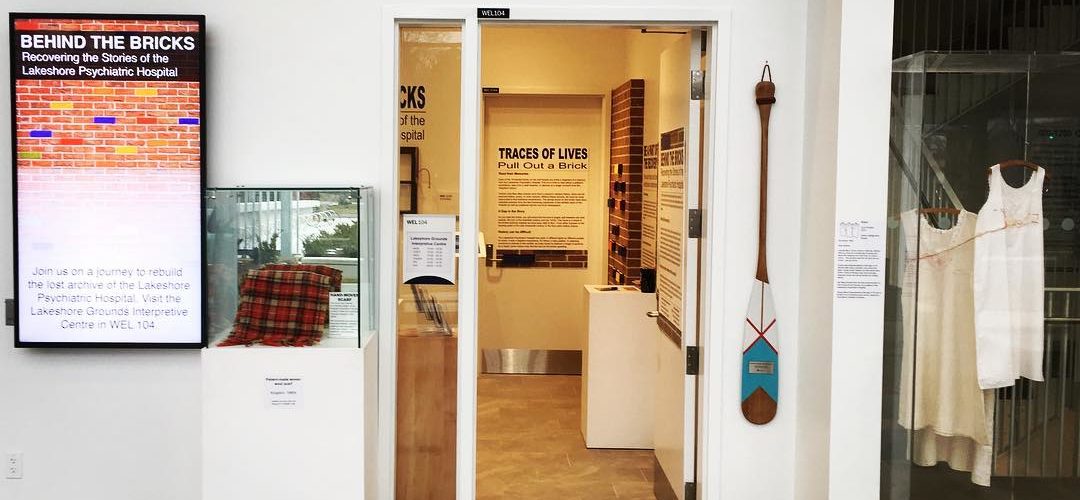
The Lakeshore Grounds Interpretive Centre has brought students many interesting local histories since its opening in 2016. Although many of their exhibits have been published here on Skedline.com, there’s one story that hasn’t been covered: who the people behind the events are and how they put the exhibits together.
Behind it all, there’s Jennifer Bazar and Nadine Finlay, the curators of the centre. Through their work, they connect local artists, residents, students and the general public to the grounds of Humber College’s past and to each other.

Skedline (SL): What is the Lakeshore Grounds Interpretive Centre? Why do you do exhibitions?
Jennifer Bazar (JB): The Lakeshore Grounds Interpretive Centre is basically a department within Humber and our mission is to research, preserve and share both the built and natural history of the Lakeshore grounds. That includes the Lakeshore campus of Humber, but also the surrounding areas that are currently occupied by the City of Toronto or the Catholic School Board. They kind of all unite together. The idea is that we host exhibits, art shows, walking tours, and different types of events — that all share that history in a different way. Because there’s a lot of ways you can talk about history, you can connect them to sort of contemporary conversations, so we try to use a culmination of approaches to be able to share those stories.

First Step: The idea
SL: When you finish hosting an exhibit, what is your very first step in hosting another?
Nadine Finlay (NF): Cleaning the space [laughs]. It depends on the exhibit. Some of them we have planned an event with different departments or community groups and others. We think of an idea, find it through research or, you know, the inspiration of the moment, where an idea just kind of appears and we talk about it and we decide to run with it.
JB: And sometimes an opportunity presents itself. For instance: this summer, we had a community group reach out to us and so we created an exhibit that wasn’t really planned at the time but we just made sure that we made space for it, whereas other projects have been in planning for months at a time. And so they’re going to overlap with exhibits that are already on display and what’s coming next. It really kind of depends on the situation.
SL: How do you promote to people to get them to display in your exhibit?
JB: One way is that we do have it on our website, where people can submit proposals to us, if they want to contribute as a solo artist or as a group artist. We also solicit artists, so we’re always attending other events, following people on Instagram, looking for potential contributors who we think that their work would complement the theme that we represent on the Lakeshore grounds. Sometimes we put out group calls. Nadine curated an exhibit recently where she put out a general call, and we had representation from different students, community members, alumni, who all then submitted individual pieces that were part of a group show. It also depends on what the particular exhibit is. Sometimes we’re just looking at partners who contribute more on the side of their knowledge about the area or knowledge about a particular topic, or materials to display.

SL: On the exhibit you’re about to hold: How did that idea come up? Describe the first day when you decided, “Okay, let’s do this”.
NF: Well, the next thing that we’re working with Humber is Aboriginal Resource Centre. This is one that’s been in planning for quite a few months. So, when you’re working with another department at Humber, you do need that longer timeline to work out different budget stuff, different planning things around each other’s schedule because they are super busy and we are super busy. So it’s just finding that time to really come together and make something good, and do a really nice presentation and work with some of their artists — do some outreach that way. So it’s been in the works since last September, if not a bit earlier. We’ve kind of been going back and forth for several months in terms of ideas, what we could do, what the possibilities are, and then how we can elaborate on some of those ideas.
JB: Probably the first step is through a conversation. We worked with the Aboriginal Resource Centre before, but reaching out and starting that conversation of, “We’re interested in working with each other again, what might that look like? What are you working on that this exhibit could connect to and complement?” It really starts with just that initial sit-down of, “We want to work together, what’s that going to look like?” and starting to brainstorm back and forth about possible ideas. And it ended up generating a longer list, so that it’s sort of like future ideas now on that list as well, even though we zeroed in on the one that we’re actually moving forward within the short term.

SL: For this event, what was the final idea for this project?
NF: You’ll have to come and see for sure [laughs]–but we’re working with three artists that are associated with the Aboriginal Resource Centre, two of whom are alumni and one is a current Humber student. They are showcasing their individual artworks — sort of ‘artworks’ used a little bit loosely there. We have a singer-songwriter and two visual artists. One of them does digital art and getting into more the fashion side of design and then the other one does traditional beadwork and painting as well. It’s how they use their artistry to speak to their own identity and how they identify as an indigenous person, and indigenous student, or alumni at Humber.
JB: And also, one of the things that’s been fun about this exhibit so far is, in addition to sharing their individual artwork, they’re also going to be sitting for interviews with us. And so we worked with Humber’s marketing communications department and filmed each of the artists individually as well as as a group. And they were each asked a series of different questions about their own background, their own family, their community, how they came to the work that they do, how that impacted who they are, how they hope to leave a lasting message for future generations, like what sort of impact they’re looking at.
And then, as a collaborative, the three of them together sat and also explored what they’re each doing and where the overlaps are, you know, they all have a very individual style and yet, some of their approaches are similar, they’re all interested in their community. That’ll be a part of the exhibit as well, those recordings.

The Aboriginal Resource Centre came up with this great idea that rather than confining the exhibits to the physical space itself, of the interpretive centre, to expand it so that it’s actually online as well. So there’s going to be a social media campaign in tandem with the physical exhibit, and the exhibit title is “hashtag: we are indigenous.” The idea is to actually call out to other indigenous artists who contribute through social media what their artwork is and how they might answer those same questions that the artists that we’re featuring answered. So that creates more of a dialogue rather than it being sort of just a static entity. They were looking for much more back and forth conversation and growing a “global community” in that way, if you will.
SL: Is it possible to create an exhibit by yourself?
JB: Like, you’re creating an exhibit, it requires a team, doing by yourself — I mean yeah I suppose that’s possible, but you would end up in a very different situation, whereas when you have a team, you have all the different ideas bouncing back and forth. You know, Nadine and I work in a partnership so that we’re sounding things off back and forth because, we have to problem-solve like, how are we going to represent that, how are we installing a particular piece, or how are we displaying it or how we’re going to integrate video into the space. And then of course, with our partners and their ideas coming in, they’re going to see things in a different light, and it’s all those voices coming together. I mean, our most productive days are when we’re all in person. So, it’s important that we’ve met with the team, that we brought all artists in at the same time, because once you have everybody around the table or standing in the physical space, it changes the conversation. If it’s all on email, that sort of thing, you get a little productivity but it’s a different kind of conversation. Like, it’s those kinds of conversations that happen, and that’s really I think how an exhibit comes together.

SL: Do you have any way that you organize coming up with ideas, do you have any method?
NF: We have several! We have several [Jennifer laughs]. There is, of course, a lot of it gets typed out over email and sort of summary conversations afterwards so even if you forget a certain aspect, you can go back over and be like, “A-ha, so-and-so said this,” because it’s right here in the email. We also are in basically constant conversation, so we have a Whatsapp group that we just kind of talk and share ideas that way, and it also is easier to catch up with people when you’re not in the space. But we also have a couple organizing things, we have calendars that we share, and of course, we use things like Trello as well to kind of keep everything in one place, more or less. But it lives in our heads a lot of the time

JB: It’s one of those things that I think, it ends up being represented in multiple ways, so you know we’ve tried the Trello boards, it looks nice and organized, but we’re also heavy on the post-it notes. And there’s emails that happen that are very formal and, ‘Here are the notes from the last meeting,’ but there’s also a whole Whatsapp conversation, and we write on the wall! [both laugh]

Second Step: Figuring Out The Space
SL: So for this exhibit here, what are the plans for the space?
NF: It’s going to be very exciting. So, each artist has a different section, and they got to choose the colour for their own section. We’re going to completely paint the walls tomorrow. But they’re also going to be unified, so along the top we’re going to have a solid colour that’s going to–fingers crossed–blend nicely into the individual colours–come back tomorrow to see how it works out! But we’re kind of having an ombre theme into sort of their individuality, that will also blend together. That’s what we’re hoping for.
Each artist is bringing in some of their own pieces, so the singer-songwriter is bringing in a guitar, the visual artists are bringing in some of their own materials and even showcasing their process, but we’re going to have a lot of iPads in here, it’s going to be very digital heavy.
SL: With putting things on the walls and having them all bring their material, do you think that sometimes it’s a challenge to contain everything in such a small room?
NF: It is. It’s a small space, and we have big ideas. So, it’s adapting those ideas to fit into the equipment that we have.
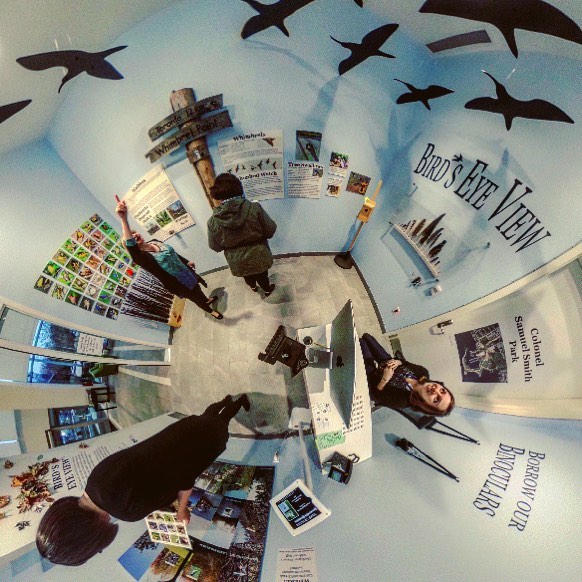
JB: But I think you could have our 200 square feet or you could have 2000 square feet, there is never enough room for an exhibit, right? You always want more space to be able to showcase more of your artist’s work or more of the topic in whatever way you’re representing it. And it, you know it’s also the kind of thing that no matter how much you plan, it comes down to the moment that you’re installing it, you end up problem-solving. We also make sure there are cars available the day that we’re installing because no matter how much you plan, there’s always something that you’re like, ‘Oh! This doesn’t work the way it was planned, we need to adapt. How are we going to adapt.’ […] And it’s trial and error, we’ve learned a lot by installing the exhibits we’ve hosted so far, and I think that each time we create an exhibit, we learn something new about how we can use the space.
But because the space is smaller, because it’s compact, we are trying to change the full visual of the space and how we’re using it each time, the colours, the components–sound has been a component in the past–the fact that sometimes we have things hanging from the ceiling, sometimes we have all sorts of cases or things happening in the middle of the space, sometimes there’s nothing on the floor. Each time we want you to visit, if it’s a new exhibit, we want it to be a fresh experience because each topic deserves it’s own individuality, it’s own space.

SL: What would you say was the hardest exhibit you’ve had to install?
NF: It depends, they all had their own challenges. We had to drill a telephone pole into the wall–which came right from Quebec–which means we had to cut it right in half, get it down here from Quebec, and figure out how to put it safely into the wall. Yeah it was a really, really challenging one. We had planets hanging from the ceiling, that one was a little bit easier, that one was kind of cool.
JB: Nadine created this amazing collage that went the entire length of one of our long walls, and it was all a series of 5 by 5 photos that were threaded by hand, sewn threaded, to create this massive wall collage of all these–almost like little Instagram squares–but hung off of fishing lines. And, it took a little finagling to get them all to align the way that looked good. That was a big one.

NF: We’ve had some interesting painting experiences, I keep trying to push the boundaries of what we can do. We’ve had triangles in space, we’ve had soon-to-be ombre in space, we’re painted multiple different colours, used light in different ways. Incorporating sound is really difficult, one, just because we’re in a very small and echoey space, but also we’re all working in this space, so choose the sound carefully because it’s what we’re going to be hearing for the next four months!

JB: Yes, we’ve learned our lesson that there are times when headphones are really important, because hearing that same thing over and over again–it’s interesting to hear if you’re a visitor, you come in, you’re here for a little bit, and you just hear that sound maybe once or twice of the video playing, or whatever it might be. If you work in this space, it’s a whole different experience. So we had to sort of acknowledge that this is also our workspace and how do we make sure that we’re comfortable or that our volunteers or students are comfortable in the space, so that’s been a learning lesson.
NF: It has!
SL: For this exhibit, what are you going to do next?
JB: So, there’s a lot that happens before it is actually seen in the physical space – the brainstorming, the planning- and then we get to actually coming to the space – buying all the supplies to install. So, step number one was we have sort of emptied the room of everything that came from the last exhibit, we’ve patched the walls -that’s always a big one-, and then taped off all of the corners so that we can get ready to paint.

SL:And then after painting, how are you going to bring stuff in?
NF: Once the paint dries, all the artists are going to come in with their own materials. They’re sending us some things in advance, we can get those off to the printer, get them formatted. Then, when they all arrive together, we’re going to actually stick things up on the walls, probably over an entire weekend, transform the space, physically drill into the walls, stick things up. Then, when the artists are here, actually making sure everything is as they envision it, as they feel their work should be represented.
JB: And some exhibits happen a little bit more over a period of days, because you’ll install in different pieces, but because this exhibit has a group of artists who are being featured, it’s important that they be there, just like Nadine said. They have a vision of how their work is about to be represented, and that needs to be right, you know what I mean? It needs to reflect kind of the vision that they have and how they want to be on display as an artist. So, that’ll be a big piece of it.
The Curating Team: The Unbeatable Jennifer & Nadine
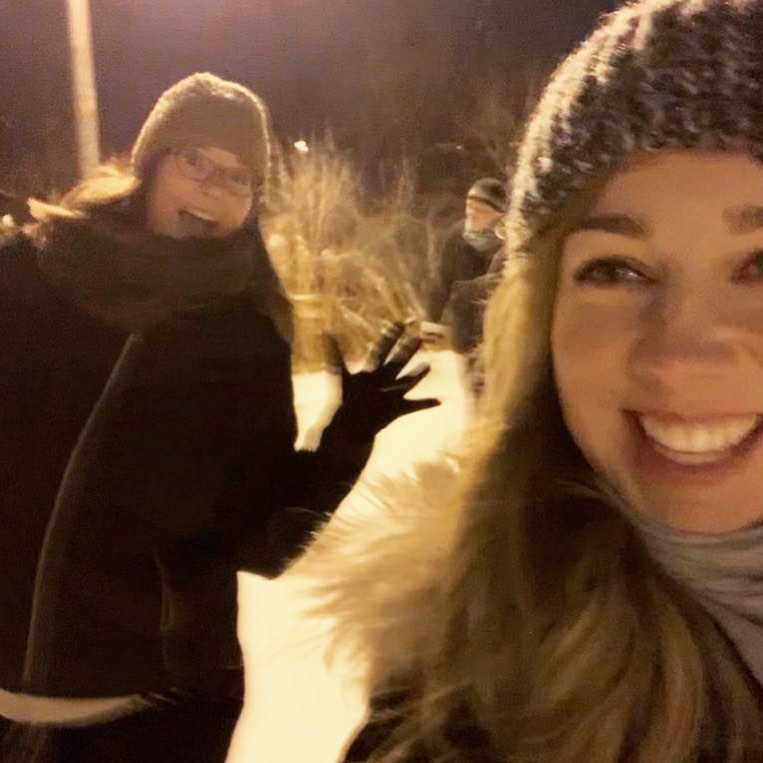
SL: How did you two end up working at the Interpretive Centre?
JB: My predecessor, long before the interpretive centre opened, was in the role of creating the plan. She went out and attended different community events and forums and hosted people, to get an idea of what the Interpretive Centre was going to be, because it was literally brand new, the building didn’t even exist yet. What we’re going to be about, what we’re going to do, what was the focus going to look like, all of those kinds of things.
And so, my initial contact with the Interpretive Centre was actually as a consultant. She reached out to me on Twitter, We chatted for a while and then we chatted by phone and then she invited me down for a tour. I got to attend one of the original tunnel tours, which was a lot of fun. Then we met for coffee afterwards and it was at that point that she said that she was stepping away to go to full-time work and that there was a position that was going to be available, and you know–might I be interested, should I put in an application–she kind of hinted at that. And I think I ran home and put in the application that day. I was very excited about what was happening here. Then, thankfully got the interview and was able to sort of elaborate why I wanted the position, why I felt like I would be a good fit. And that was sort of where it started from.
NF: So I came to the Interpretive Centre a little bit of a different way. It was just before it actually officially opened, Jennifer came and gave a tunnel tour to one of my classes when I was at Humber. We had a project in class where we had to do some volunteer work so I just emailed Jen and asked if I could come in for a meeting and she was like, ‘Sure no problem.’ And I walked in with my resume and said I want to volunteer for you, here’s the project that I want to do and Jen was just like, ‘Yeah ok.’ So that’s kind of how I started, I started off as a volunteer intern, and then I got hired on as a summer intern, and then I got hired on again as the assistant curator and I have not left yet so, things are hopefully pretty good. [laughs] I have not been kicked out yet!

SL: What is your background for coming to work here?
JB: So, my degree is in the history of psychology. I had finished my PhD, I was working on a postDoc and I was up in Penetanguishene, at their mental health centre. I was doing research, I was creating a digital exhibit and archive, I was creating a physical exhibit, and it sort of got tied into some walking tours as well. My background is in the history of psychiatric institutions. And then, since becoming the curator here, it’s really been an awesome opportunity because it’s given me a chance to expand that knowledge base to a lot of other topics. So I’ve learned things about the history of education in Ontario, about birding–I’ve become a birder as a result of being here, because you just fall in love, you can’t not be–I’ve learned about indigenous heritage on this site, about farming history, about factories, it’s been really nice.
NF: My undergraduate is in English and Anthropology and I kind of came to the Interpretive Centre looking for that museum experience, and from that museum background. I came to Humber for Arts Administration and Cultural Management which is a one-year post-graduate certificate. And I’m just finishing my masters of museum studies at the University of Toronto. So, that part has always been a little bit easier, where in museums you are always given a topic and told to run with it. So that’s kind of how I came to the space.
SL: So you’re very different people, different backgrounds.
JB: But I think that what works too, is that there’s a complement. So, I learn things from Nadine on a regular basis, I’m hoping she might learn something from me.
NF: Every day!
JB: And also, our interests are such that it always overlaps with what we’re doing at work as well. I think we complement each other well in terms of how we approach different projects. Even like, she’ll run one idea and I can think of another way of doing it, and then I try to think of something and then she has a way of actually implementing that, you know, like it’s that back and forth. And of course, every student that we bring in, every volunteer that we work with, partners – they’re all contributing to that as well. So it becomes–like it’s never just the two of us, it’s always a larger team and lots of voices. And it’s how those start to come together that I think makes the exhibits unique. And hopefully interesting.

SL: Do you have a heart and the head of the operation or are you both the heart and the head?
NF: That depends on what we’re talking about, depends on the day, depends on the conversation, depends on the coffee, and the activity.
JB: Yeah, I think it goes back and forth
NF: Definitely.
SL: What is your favourite part of what you do?
NF: All the things. [both laugh]
JB: That also depends on the day. There are days where I think we fully geek out about research, like I mean, excited–beyond excited about something new that we just read about. It’s like, ‘Oh my gosh, this is the greatest thing ever.’
NF: History of trees is super fascinating. [laughs]
JB: Right? It’s amazing. But then there are other days where it is so satisfying when you’ve installed something within the exhibit and it worked the way you envisioned
NF: When you paint a straight line, ‘oof,’ that’s like the best moment.
JB: But then there are also those moments where we go into a class or we’ve hosted one of our monthly tours and it’s super satisfying, like, you come out of it and you’re like, ‘That was a great tour.’ you know what I mean, some are better than others, like we all have good days and we have bad days, and it just feels really nice, you know, maybe you get really good questions, I always react well to those.
NF: Yeah, or someone says something and it comes back to you through the grapevine, like, ‘I really enjoyed this tour, you need to go on it.’ And it’s like, we are doing something good, because someone has enjoyed it and then spread that forward so that more people can come and experience things, you know, that we’re putting on, because there are interesting things that we talk about, it’s not just for the sake of putting up an exhibit, there’s a story behind it. So seeing the larger impressions of what we do is also awesome.
JB: And also hearing feedback about our students. Our students host a lot of art events and our tours, and they’re engaged in creating the exhibits–it depends sort of on what their interests are, what semester it is, all of that. And so then, hearing feedback about their work is really satisfying, and it’s nice to see their work being recognized.
NF: So basically everything!
SL: What does the Interpretive Centre mean to you?
JB: That is a really hard question. So for me, I think–and I’ll probably change my answer the next time you ask, it’s probably one of those developing kinds of answers–the Interpretive Centre for me has meant a couple different things. One has been, allowing me to grow so that it complemented my education, it complimented my background, allowed me to use my skill set that I had, but also allowed me to explore new avenues. I sort of see it in terms of topics sometimes, but it was new skill sets, new research topics, even new types of engagement with students. My previous life, if you will, was more a classroom environment, I’d always talked. And so it’s new audiences, like we work with the public all the time, we’re still working with students, but in a different capacity. They’re not seeing us every single day, they’re seeing us when we come in for a workshop or we come in for a tour, you know, whatever those circumstances might be. So it’s been a lot of growth, development, some exploration. The role allows us to try things and see if they work. And that’s been really enjoyable I think, from a personal perspective. There’s been a lot of development just as an individual. I think I’ve grown in the few years I’ve been here and, I think the role and the team have allowed me to do that, so I’m grateful for that.
NF: I think the Interpretive Centre , to add to that, is also great to interact with people in different ways. So, you can’t really walk up to someone on the street and go, ‘Hey, want to hear some history?’ [laughs] People look at you strange, I mean, you wouldn’t get the same reaction whereas if you come in this space you are expecting to have that conversation and it’s a little bit more open. You’re talking about the topic at hand, but that leads to larger discussions where people are thinking about things differently, they’re seeing spaces differently, they’re experiencing, you know, the grounds. We’re even taking things, new information in, that might change their way of thinking, and maybe be open to a different way of thinking, which is kind of cool. But it’s also helped connect in ways I didn’t think it would, like I now have a whole different section of conversation to have with my grandpa because I just found out he used to live in this area and he knew about this random small topic that I came across and he’s like, ‘Why didn’t you say so?’ And I’m like, ‘I didn’t know!’ So being able to have just that whole different style of conversation with a family member who no longer lives in the area and I didn’t actually know lived here. So we’re going to have a chat next time. But meeting people, and connecting with people and learning from them I think is the coolest part about the Interpretive Centre.

JB: Even the strangers coming to the space, I mean one of our favourite things that we often talk about is like, somebody comes in, is coming to have a conversation about the exhibit or attend one of our tours, and then is actually sharing their own experience with us, their own knowledge, and that’s huge, that’s a lot of fun.
NF: Connecting people to people, and information to people.
SL: Why do you think it’s so important to have people come here and see these exhibits?
JB: On the one hand, I think that this space that the campus occupies, the Lakeshore Grounds area, is a really unique site in terms of the fact that it just has multiple histories on it. Even just walking around the campus you can see that in the landscape, in the park that’s been added onto the shoreline, in the built structures and the fact that they all come from different generations.

It really has a lot of stories in a small space, all the communities that connect here, of the Etobicoke-Lakeshore area, there are these older histories, there are these stories, and this space sort of offers those as well. So, I think that there’s a component of–those stories exist within their local communities, people are interested in sharing and learning from one another and so the Interpretive Centre helps to provide sort of one space in which they can do that.
In terms of a student side though, I think it’s one of the things that makes the Lakeshore campus unique. I mean, Humber has multiple campuses and they each have their own personality, but it’s something that makes the space special, it has awesome programs, but they’re also offered in a very cool environment. As soon as you come on a tour of the campus, I think people become interested. You don’t have to be a history buff to be curious about the movies that were filmed here and how you can see those, or you know, why are the buildings so different, and why do they date back to the 19th century, and who was here before, and what does it mean that it was a hospital, and why is it such a unique natural environment right on our, sort of right at the edge of campus, there’s this beautiful park where a Snowy Owl comes every winter. It just offers a lot of those kinds of questions and so being able to provide a space to have those conversations, to explore those questions I think becomes important from a number of different perspectives.
uNF: It also helps other people understand other people. Like if someone’s walking through here with their dog, and their dog is off-leash, you’re not supposed to do that and someone might say, ‘Oh well this is what I want to do, my dog really enjoys it.’ But if we come in here, and we have an exhibit about birds, they’re going to be like, ‘oh look at this whole community that is specifically focused on making sure that this one species of bird that nests on the ground is safe, and by my dog being lose, this bird id no longer safe.’ So they’ll change their behaviour. Hopefully, by introducing that information in a new way, because if you go to somebody in a park and say you can’t do this, that’s not really going to go over well and you’re not really learning anything from it, you’re not knowing why, you’re not understanding why. So coming in and seeing why other people are the way they are.
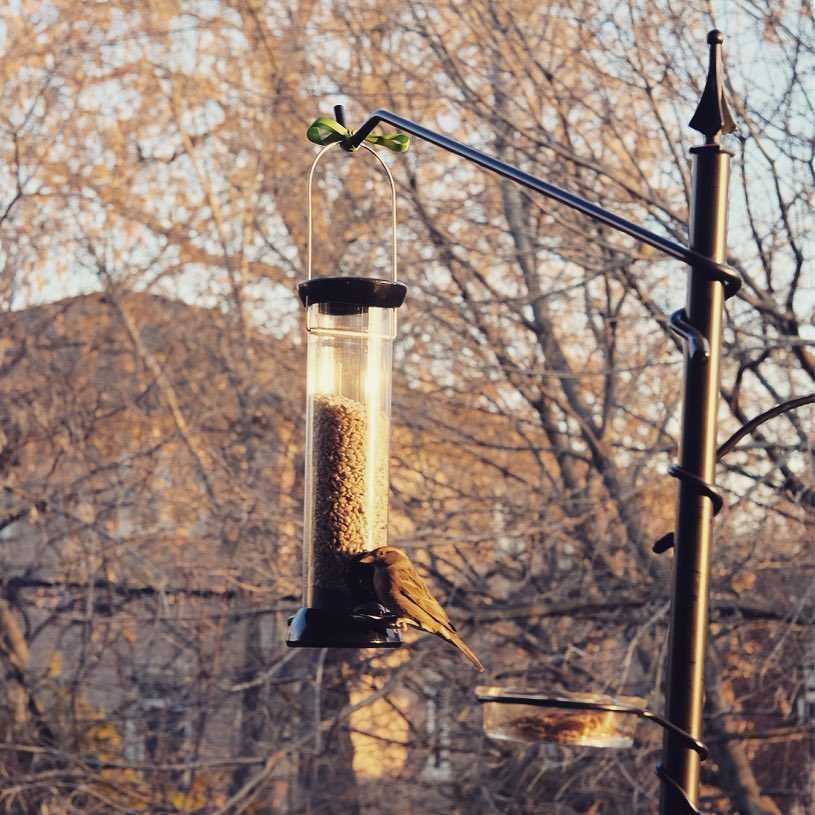
SL: What would be a tip you would give someone in terms of exhibit creation?
NF: It’s really fun. It sounds dramatic but it’s actually really fun to see everything come together and have all your ideas be physically manifested around you.
JB: It’s a unique challenge. It’s, you know, how do you capture an idea? You might be able to talk about it or write about it in one way but how do you bring it into a visual that people are going to engage with? It changes how you view other exhibits, so that you can never again go to a museum or a gallery in the same way because what you’ll do is–you don’t experience it as a visitor anymore, you experience it as a creator. You’re constantly looking behind things, going ‘How did they hang that?’ and ‘How did they install this? What are they doing there? That’s cool, I can see the projector there.’ Like, you’re always looking at it now in a different way because you’re looking frightened. Like you know, how can I bring that into our space and borrow from what they’ve done or modified it in some way. So, it changes how you look at things
SL: In three words, how would you describe the work that you do?
NF: Organize. Spontaneous. Creative.
JB: I agree with almost all of those, I’d say: Creative. Adaptable. Resourceful.
SL: Any final thoughts you want to share with people?
NF: Come see the exhibit and talk to us, we’re really nice! [both laugh]
JB: I think that’s the biggest thing, is we love engaging with people and that’s what makes the job enjoyable, is we are literally hired to chat about the grounds, about history, about what we’ve learned, and about what we’re able to find out about the area. Hopefully, people come and continue those engagements. It’s always free, everything we do is free and everything we do is open to the students and to the community, so regardless of where they’re coming from, we hope that they’ll join us.
SL: If someone wants to come to an exhibit here, where can they find information about it?
NF: Well, we have posters all over campus, we also use Humber TVs, and post different promo ads there. A lot of it is word of mouth, but we also have an e-newsletter, the usual Facebook, Twitter, and Instagram. And we’re working on posting some of that information to Eventbrite to really push it out there.
JB: And probably the one communal spot where you can find links to all of that information is on our website which is www.lakeshoregrounds.ca. And then you can find our social media and find our zine, which is our little in-house publication, you can find our newsletter, you can find the Eventbrite links which I think are also on there.
NF: You can also find our emails to ask us directly.
JB: So lakeshoregrounds.ca is probably the best way to go.
UPDATE: Their current exhibit will no longer be open to the public at the Welcome Centre building due to COVID-19. People can digitally check the #WeAreIndigenous exhibit, which will be released April 30 at the virtual artist’s reception.
Photos by the Interpretive Centre Instagram’s page.
